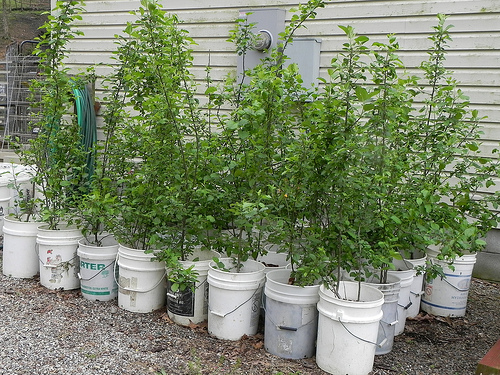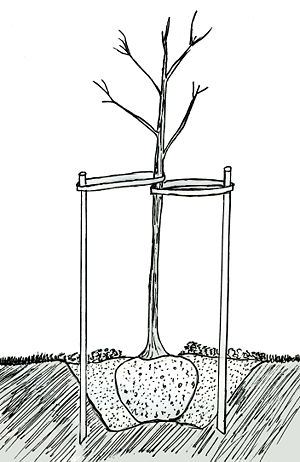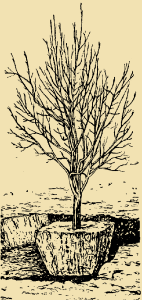Transplanting an apple tree is an important part of tree care
By planting an apple tree in your garden, you will receive a tasty and large harvest for more than a dozen years. The apple tree is the most common fruit tree in our country. It can be found in absolutely any garden. But she requires constant attention and supervision in order to bear fruit for a long time. It is necessary not only to plant it correctly, but also to take care of it, and sometimes there is a need for its transplant. However, it should be remembered that this process is stressful for the tree. In order for the transplant to be successful, you need to adhere to certain rules.
Content
When is the best time to transplant?
Many people wonder when and how to transplant an apple tree correctly? Indeed, on how correctly the tree is transplanted, its yield, as well as life expectancy, depends.
Professional gardeners say that the best time to transplant a young apple tree is mid-autumn or early spring. But summer is not particularly suitable for this procedure. The timing of the transplant depends on your preferences, but there are some nuances:
- it is best to transplant in the spring if your land plot is located in a non-black earth zone;
- if autumn was cold and dry, then it is better to replant in spring too;
- in spring, the transplant is best done on non-sunny days;
- in all other cases, the transplant is carried out in the autumn.
In order to properly transplant an apple tree in autumn or spring, you must wait for the dormant period of the tree. In the spring, the transplanting process should be completed before the buds open, and in the fall, it is worth starting only after all the leaves have completely fallen off. If you transplant an apple tree in the fall, then you need to have time to finish everything before the onset of frost (preferably two weeks, or even a month before them), otherwise the roots will not have time to adapt to the new place of growth. If, nevertheless, there is a need to transplant apple trees with leaves, then it is best to transplant them in the evening. At this time, the processes of enhanced evaporation of water by leaves are completed, and the process of photosynthesis is also completed.
Large and mature apple trees can be replanted in winter. But in this case, the air temperature should not be lower than 5 ° C.
It should also be remembered that when replanting apple trees, you need to maintain the same orientation of the tree in space. Orientation is understood as the directionality of the branches of the tree to the cardinal points.

Instructions
The following points will tell you how to transplant an apple tree:
- first you need to prepare everything you need for transplanting: gardening tools, dense ropes, cloth bands, root boards or matting, water, stretch marks and planting stakes;
- prepare a pit for the transplanted apple tree in a new place. The size of the pit should be increased approximately 1.5 times the size of the earthen coma that the transplanted tree will have. The pit is cleared of weeds. The soil over the entire surface of the pit must be filled with limestone and organic matter (provided that the soil is highly acidic);
- prepare the stakes that you will use to support the transplanted apple tree (there are at least three of them);
- mark the sides of the horizon on the trunk with paint or chalk;
- the apple tree, as far as possible, is dug up with the main roots, as well as a large lump of earth;
- the entire volume of the root system during transplantation should be at least half of the total volume of the crown;
- do not shake off the ground from the roots;
- before digging, as well as during transportation, the trunk should be tied with a soft cloth. This is done in order not to damage the bark of the trunk;
- an earthen lump should also be packed in a net, matting or sheathed with boards;
- skeletal branches must be carefully bent to the trunk;
- if there is such an opportunity, then it is better to immediately plant the tree in the chosen place, since the less time has passed between digging and planting, the more successful the engraftment will be in the new place;
- it is necessary to plant a tree in a new place while maintaining the same orientation (to be guided by the marks on the trunk);
- an earthen lump should be placed in the planting pit in such a way that the root collar is slightly above ground level;
- cover the roots with fertile loose soil without gaps;
- the transplanted tree should be well watered;
- tie the apple tree to the stakes.

There are small additions to the above instructions regarding the soil into which the tree will be transplanted:
- if transplanted into clay soil, then the pit should be made deeper. At its bottom, you need to put a drainage layer (empty cans, stones, wood trimmings). Drainage will provide the roots with additional nutrition and air supply for a couple of years;
- if transplanted into sandy soil, then instead of drainage, a water-retaining layer of clay or silt is placed.
Apple tree transplant video
You can watch the correct transplant process in the video.
How to transplant an adult apple tree?
Sometimes there is a need to transplant an adult apple tree. Before transplanting it, you need to be sure of the need for this procedure.
Adult apple trees can be transplanted provided they are less than 15 years old. At the same time, for dwarf rootstocks, this period can be increased.
In this case, for a successful transplant, you need to keep the main roots intact, as well as their branches, to prevent the roots from drying out. Correct pruning of the crown, preventing the bark of the tree and branches from drying out and providing the apple tree with nutritious, good soil and proper care will also significantly increase the chances of good engraftment in a new place.

If you follow the basic rules, then the transplant will take place for the apple tree with minimal stress. This procedure is an important part of care, and if all the subtleties are observed, the transplanted apple tree will be able to delight you with its harvest for a long time.
